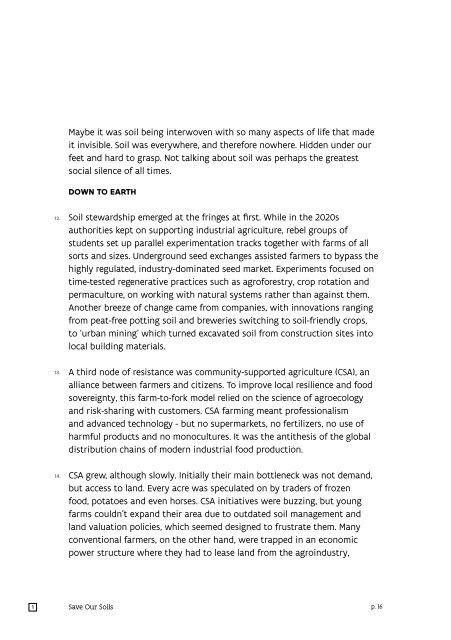The Future of Soil and Land Stewardship - An exploration of stewardship in three scenarios
- No tags were found...
You also want an ePaper? Increase the reach of your titles
YUMPU automatically turns print PDFs into web optimized ePapers that Google loves.
Maybe it was soil be<strong>in</strong>g <strong>in</strong>terwoven with so many aspects <strong>of</strong> life that made<br />
it <strong>in</strong>visible. <strong>Soil</strong> was everywhere, <strong>and</strong> therefore nowhere. Hidden under our<br />
feet <strong>and</strong> hard to grasp. Not talk<strong>in</strong>g about soil was perhaps the greatest<br />
social silence <strong>of</strong> all times.<br />
DOWN TO EARTH<br />
12.<br />
13.<br />
14.<br />
<strong>Soil</strong> <strong>stewardship</strong> emerged at the fr<strong>in</strong>ges at first. While <strong>in</strong> the 2020s<br />
authorities kept on support<strong>in</strong>g <strong>in</strong>dustrial agriculture, rebel groups <strong>of</strong><br />
students set up parallel experimentation tracks together with farms <strong>of</strong> all<br />
sorts <strong>and</strong> sizes. Underground seed exchanges assisted farmers to bypass the<br />
highly regulated, <strong>in</strong>dustry-dom<strong>in</strong>ated seed market. Experiments focused on<br />
time-tested regenerative practices such as agr<strong>of</strong>orestry, crop rotation <strong>and</strong><br />
permaculture, on work<strong>in</strong>g with natural systems rather than aga<strong>in</strong>st them.<br />
<strong>An</strong>other breeze <strong>of</strong> change came from companies, with <strong>in</strong>novations rang<strong>in</strong>g<br />
from peat-free pott<strong>in</strong>g soil <strong>and</strong> breweries switch<strong>in</strong>g to soil-friendly crops,<br />
to ‘urban m<strong>in</strong><strong>in</strong>g’ which turned excavated soil from construction sites <strong>in</strong>to<br />
local build<strong>in</strong>g materials.<br />
A third node <strong>of</strong> resistance was community-supported agriculture (CSA), an<br />
alliance between farmers <strong>and</strong> citizens. To improve local resilience <strong>and</strong> food<br />
sovereignty, this farm-to-fork model relied on the science <strong>of</strong> agroecology<br />
<strong>and</strong> risk-shar<strong>in</strong>g with customers. CSA farm<strong>in</strong>g meant pr<strong>of</strong>essionalism<br />
<strong>and</strong> advanced technology - but no supermarkets, no fertilizers, no use <strong>of</strong><br />
harmful products <strong>and</strong> no monocultures. It was the antithesis <strong>of</strong> the global<br />
distribution cha<strong>in</strong>s <strong>of</strong> modern <strong>in</strong>dustrial food production.<br />
CSA grew, although slowly. Initially their ma<strong>in</strong> bottleneck was not dem<strong>and</strong>,<br />
but access to l<strong>and</strong>. Every acre was speculated on by traders <strong>of</strong> frozen<br />
food, potatoes <strong>and</strong> even horses. CSA <strong>in</strong>itiatives were buzz<strong>in</strong>g, but young<br />
farms couldn’t exp<strong>and</strong> their area due to outdated soil management <strong>and</strong><br />
l<strong>and</strong> valuation policies, which seemed designed to frustrate them. Many<br />
conventional farmers, on the other h<strong>and</strong>, were trapped <strong>in</strong> an economic<br />
power structure where they had to lease l<strong>and</strong> from the agro<strong>in</strong>dustry,<br />
1 Save Our <strong>Soil</strong>s<br />
p. 16


















